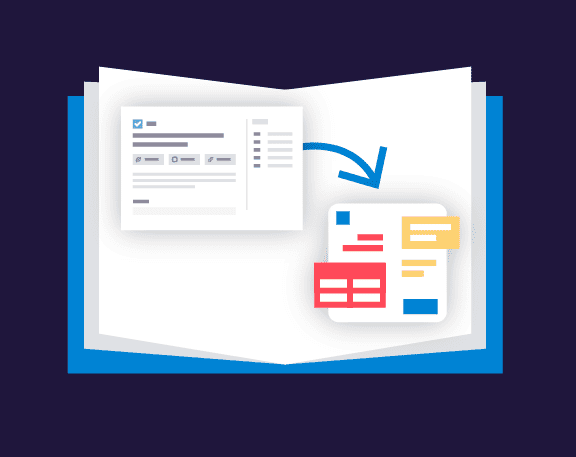Use case benefits
Use support agents’ comments to create pre-filled knowledge base articles
Create knowledge base articles or FAQs that include detailed instructions from a support agent by inserting the ‘last comment’ variable onto your template. Embedding Jira comments onto new Confluence pages with Elements Publish will help you quickly build out an entire library of how-to’s and FAQs.
Insert the key data from your JSM request, like the last comment, into standard Confluence templates like the How To and the Troubleshooting templates Or a custom template your team created. You can also design your article layout directly in Elements Publish. Blueprint or custom layout: your new knowledge base articles can look great.
Depending on the process that works for your team, you can let agents choose when they create a new knowledge base article, or set it and forget it so there’s no extra step for agents. Elements Publish recipes can be triggered manually, as a post-function on a transition, or by any of the triggers in Automation for Jira thanks to our public REST API.

Tutorial
Copy Jira comments to Confluence pages
As a Jira administrator, you want to make relevant information from a Jira issue, including what is in comments, available on a Confluence page. Jira comments can be inserted into the body of a Confluence page, making the information searchable for Confluence users.

Have questions about publishing Jira comments to Confluence?
FAQ
Can I choose which comments are published?
You can choose between all comments, first comment, or last comment.
Use case benefits
Leverage the information from your incidents tracked in Jira by publishing it to Confluence
Elements Publish recipes allow you to pre-configure the parent page, design a template that mixes static content and details from your Jira issue, and link to the new page in the Jira incident. With everything prebuilt, Jira users can focus on the root cause analysis, not copying and pasting.
Inject information from Jira onto the post-mortem page: issue details, field values, attachments, and even labels. Get the layout you want by inserting issue details into tables or adding panels, action items, or statuses. You can even use issue details or field values to dynamically set the page title.
Elements Publish recipes can be triggered manually by Jira users, added as a post-function to a transition, or integrated into an Automation rule. Fine-tune who can create the post-mortem by adding user conditions based on user groups or identify.

Tutorial
Make your team’s processes even more efficient by inserting Jira data into Confluence templates
If your team is already using Confluence templates which meet their needs, there is no reason why that should change. Learn how you can embed issue data from Jira into Confluence templates with no coding or webhooks to configure.

Have questions about inserting Jira fields into Confluence templates?
FAQ
What fields can I insert on Confluence templates?
There are over 20 different types of fields you can insert. You can find the full list of fields you can copy from Jira to Confluence on our documentation.

















